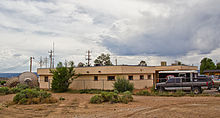KTNN
This article needs additional citations for verification. (April 2011) |
| Frequency | 660 kHz |
|---|---|
| Programming | |
| Language(s) | Navajo/English |
| Format | Country music/Navajo cultural programming |
| Ownership | |
| Owner | The Navajo Nation |
| 96.1 KWRK; 5 TV translators | |
| History | |
First air date | February 26, 1986[1] |
Call sign meaning | The Navajo Nation |
| Technical information | |
| Facility ID | 66146 |
| Class | B |
| Power | 50,000 watts |
Transmitter coordinates | 35°53′42.0″N 109°08′31.3″W / 35.895000°N 109.142028°W (NAD83) |
| Links | |
| Webcast | Stream (WMA2 at 70 kbit/s) |
| Website | www.ktnnonline.com |
KTNN is a Navajo language AM (medium-wave) radio station broadcasting on 660 AM from Window Rock, Arizona, the seat of the government of the Navajo Nation. It broadcasts Navajo tribal music and audio from Navajo ceremonial (powwow) dances and Native American music, as well as country music and bluegrass in English.[2] Most of its announcers are bilingual and broadcast in Navajo and English.
The station is notable because it was the last AM station in the United States to receive a license for a 50,000 watt station on a clear-channel frequency from the Federal Communications Commission (FCC).[3][unreliable source?] KTNN's nighttime broadcast signal covers a broad section of the western region of the United States, including vast rural areas of the American Southwest and the entire 26,000 square miles (67,000 km2) comprising the Navajo Nation.

Many households in KTNN's listening area do not have access to cable television and those that do receive news from network stations originating from Albuquerque and Farmington, New Mexico, leaving a large need for news and information directly related to those living on and around the Navajo Nation. KTNN's broadcast coverage thus fulfills the historic intent behind the FCC's licensing of 50,000-watt 'powerhouse' stations,[improper synthesis?] since these clear channel licenses were originally issued to provide a means to reach those who lived in rural areas with reliable radio service.[4]
KTNN's daytime signal covers much of the Four Corner states; in contrast, its nighttime signal can be heard throughout most of the western United States, reaching as far away as the Central Coast of California and even countries around the Pacific Rim. During nighttime, the station uses a directional antenna to protect the signal of WFAN in New York, as required by FCC rules, since WFAN is a Class A (formerly Class I-A) station broadcasting on 660 kHz, whereas KTNN is Class B (formerly Class II-A). Class A stations such as WFAN have a protected nighttime skywave (secondary) service area, but Class B stations do not.
See also
References
- ^ "KTNN First Air Date" (PDF). Broadcasting & Cable Yearbook. 1998. pp. D-28. Retrieved August 17, 2012.
- ^ Pritzker, Barry M., Native America Today: a guide to community politics and culture, ABC-CLIO Press (1999), ISBN 1-57607-077-8, p. 73
- ^ Pritzker, Barry M., Native America Today: a guide to community politics and culture, ABC-CLIO Press (1999), ISBN 1-57607-077-8, pp. 72-73[unreliable source?]
- ^ Rural Radio Magazine, Vol. 1 No. 1, Clear Channel Group (November 1938), p. 2
External links
- KTNNOnline.com - Official Website
- KTNN in the FCC AM station database
- KTNN in Nielsen Audio's AM station database
